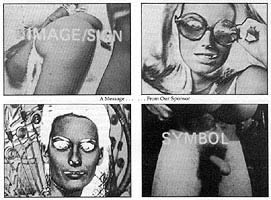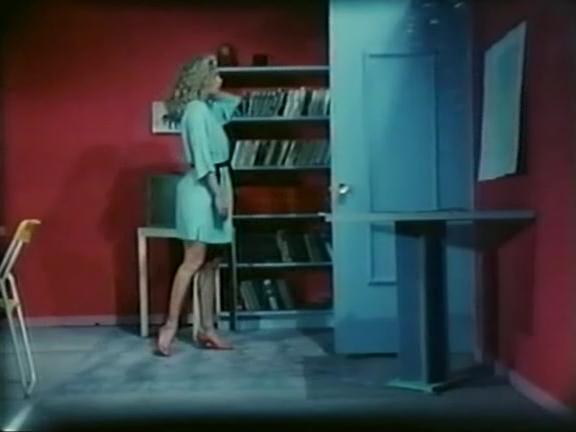A Chronology of Censorship in Ontario by Judith Doyle (1981)
(excerpted from the original)
In March 1980, an Inspector from the Ontario Theatres Brank visited The Funnel Experimental Film Theatre in Toronto, and told its directors that they’d better get licensed. Obtaining a license means submitting every film you would screen to the Ontario Board of Censors and abiding by their classifications. That might entail submitting a film to cuts, not screening it, or being liable for prosecution. The Board went on to demand the same compliance from artists’ groups, film centres and festivals across the province. When the OBC hit The funnel, they were setting a precedent in Ontario and the rest of Canada. Film by artists had never been routinely censored in this country before.
The OBC has no procedural guidelines; in law, it has unqualified authority to cut or ban what it will, and jurisdiction over the advertising and public screening of films, videotapes and slides in this province. The arbitrary, unaccountable way it exercises its authority has become obvious over the last year and a half. May Brown present Chairperson of the OBC, has come to personify such authority. But the OBC’s brand of authority – as this chronology should illustrate – has existed in law and in practice for seventy years.
When the Canadian Images Festival at Trent University defied the Ontario Censor Baord by screening an uncut film by artist Al Razutis – once the matter was “out of (Mary Brown’s) hands” – it moved into the hands of a “P” Squad investigation. The “P” Squad is an amalgamation of Provincial Policie and Metro Toronto’s Morality Squad – who brought us the gay bath house raids last February.
This chronology is incomplete. There is no list of film swhich the OBC has cut or banned, because until January 1981 that information was a sworn secret. There is no list of censors – who they were hired by, their qualifications or connections. Until 1979, the names of the Ontario censors were also secret. There is no list of galleries approached by the Metro Toronto Morality Squad – no list of works removed at their suggestion – because such suggestions are covert, under-the-counter deals, made without warrants, without charges, and without judicial inquiry.
And the chronology is incomplete because the facts are dispersed through clipping files, annual reports, articles, books of Revised Statutes, and Federal, Provincial and Municipal Legislation. The only complete records are in the safekeeping of the Ontario Censor Board, the “P” Squad, the Metro Toronto Morality Squad, the Customs and Importation Office, and the RCMP.
(edit here)
1975
Attorney General of Ontario Roy McMurtry established the “P” Squad – a special anti-pornography unit combining Metro Toronto Police and Ontario Provincial Police. In 1981, it is rumoured that McMurtry gave final approval to the February 5 Gay Bath raids – where 150 officers smashed four Toronto Bath Houses, arresting 286 gay men.
1977
Mary Brown was appointed Vice-Chairman of the OBC; with the OBC answerable to the Minister of Consumer and Commercial Relations, Frank Drea. At this point, the OBC was the only Censor Board in the country which still would not publish the names of its members, or any information about the cuts it made.
1978
Mary Sexton, a Toronto lawyer, was hired by the Ontario Censor Board. This was the first and only time that a job on the OBC was tendered publicly and advertised in the press. One of the most liberal members of the OBC, Mary Sexton publicly stated she was not in favour of censorship at all, but rather a system of film classification. She was the first member of the OBC ever to resign, in September 19081. She said, “I felt I had to resign before being forced out.”
1979
Under Donald Sims name, Mary Brown circulated a list of “Guidelines” to the OBC, which are still in use at present. A number of specific acts are forbidden, though these are prefaced by the ambiguous phrase “depending on the circumstances.” The Body Politic, a Toronto gay newsmagazine, was acquitted from charges of “transmitting indecent, immoral or scurrilous material through the mails” over material on pedophilia. Before the trial, a number of files were seized from The Body Politic’s offices.
During the late 70’s, under the Directorship of Donald Sims and Mary Brown the OBC brought wave of publicity and notoriety upon itself which would have been intolerable to former Chairman O.J. Silverthorne. The OBC rejected or demanded significant cuts in a number of well-known American and European films – including Pretty Baby (rejected without appeal, to prevent “child porn” from entering Ontario in the future; 1976), Coming Home (the love scene between Voigt and Jane Fonda was shortened; the film was later shown uncut on Toronto’s CITY TV), Luna (7 cuts were made to excise any indication of ‘incest’; 1979), The Legacy (the sound of a dog crunching a human bone was deleted), and – with most controversy of all – The Tin Drum (4 cuts were demands. When the Director and Distributor refused, the film was withdrawn from the Province.) Debate on The Tin Drum would break the internal solidarity of the Board, opening it to a degree of public scrutiny in 1980-81.
1980
1980 and 1981 mark the invention of the OBC into areas of production it had historically ignored – filmmaking and video by artists and special interest groups. To do this, the Board had to assert its authority over a number of spaces it previously had not approached – art galleries, artist-run centres, video co-ops and community centres.
March 1980
A Theatres Branch inspector referred the Directors of the Funnel to OBC Chairman Donald Sims, who was adamant that the same rules should apply to this non-profit, artist-operated space as to a commercial movie house. This meant all films and videotapes had to be submitted for approval, classified, cuts could be demanded, certificates issued. Fees had to be paid for the censoring of non-Canadian films ($10 for every 400 ft. of 16mm film, and $2 per minute of Super 8 and videotape), and all films had to have an embossed stamp reading “Approved, Ontario Censor Board” placed on the picture part of the film.
The Funnel enlisted the assistance of the Ontario Arts Council, and were given an exemption from the stamping rule, from submitting their advertising, and were promised same-day service. The Ontario Arts Council agreed to help the Funnel cover the costs of sending films up and from the OBC. The Funnel got its license from the OBC; ironically, via the Funnel, the OBC would get its hands on, and be able to demand cuts from, a majority of artists’ films in this country.
The Funnel operated for three years before the OBC intervened, showing films within a small, specific community with “community standards” that differed fundamentally from the majority of the Province. Artist’ films are produced in a different historical and intentional language than commercial film. As such, it lies at the undefined border of the OBC’s jurisdiction; whether artists’ film is their legal business or not is still in question.
June, 1980
At a Hearing of a Justice Committee of the Ontario Legislature, four out of five of Ontario’s censors testified under oath that they had been intimidated by Chairman Donald Sims and Vice-Chairman Mary Brown to demand cuts in The Tin Drum. Unless they took a hard line with The Tin Drum, they could lose their jobs. During the hearing, Donald Sims instructed Mary Sexton not to discuss legalities with the other censors. A month later, Sims retired and Mary Brown became Chairman.
September, 1980
Mary Sexton resigned from the OBC. The Funnel submitted a package of films curated by the National Gallery of Canada and distributed by the Canadian Filmmakers Distribution Centre to the OBC, who demanded that three cuts be made in Al Razutis’ And Now a Message From Our Sponsor. Mary Brown hinted, in a clandestine discussion with National Gallery officials, that the film might be violating the Criminal Code. (An act of “pre-interpretation” she had no right to perform.) Rather than appeal or fight, the National Gallery dropped the film from its Series across the country. Artists objected that the package of films had already been screened at the National Gallery. Mary Brown countered that, as Federal Property, the National Gallery was exempt from its jurisdiction. On other occasions, the OBC has argued that such exemptions no longer applied. This legality has never been clarified. Artists, filmmakers and the press across the country argued against this first censorship of an artist’s film – to no avail. Razutis refused to permit the cuts, and the film was not shown.
January, 1981
The Ontario Censor Board began releasing names of films it had cut and information on those cuts. This telephone service is unpublicized and does not apply to films censored prior to that date.
4 March 1981
The OBC demanded cuts in Michael Snow’s most recent film Presents, which would stop its world premiere at the Funnel.
5 March 1981
The Funnel appealed, and the OBC reversed its decision on Presents.
6 March 1981
Three days before Fuse Magazine was to screen Less Medium, More Message, a twelve-hour survey of recent video documentaries, they were informed by Mary Brown that the planned closed-circuit screening “constitutes a public exhibition.” The screening was to take place at Trinity Square Video, a Toronto community-access video centre. Fuse decided to take the OBC to court, in the hopes of getting “a public ruling on legitimate exemptions.” Lisa Steele, co-editor of Fuse: “The Board of Censors is not only interfering with artists’ films and artists’ videotapes but is now preventing the working women’s community from seeing important research on sexism, labour, women’s hostels, immigration and family violence.” Shortly afterwards, Fuse was forced to drop charges on the threat of a counter-suit. Less Medium, More Message was the fourth video survey organized by Fuse, and the first to be blocked by the OBC.
13 March 1981
The OBC ruled that Rameau’s Nephew by Diderot (Thanx to Wilma Shoen) could not be shown at the Funnel unless it was cut. Snow unconditionally refused to cut the film. Rameau’s Nephew had already been shown in Ontario at the University of Toronto, the National Gallery, the Art Gallery of Ontario, the Ontario Institute for Studies in Education, York University and the Funnel itself.
Canadian Images, a film festival connected with Peterborough, Ontario’s Trent University and Artspace, a Peterborough artist-run centre, defied the OBC by screening Al Razutis’ And Now A Message From Our Sponsor. The President of Trent University backed this screening. When asked about the penalties the Festival Director said, “Different lawyers told us different things. Confusion exists because the Theatres Act is open to interpretation, and the festival’s action is thought to be unprecedented.” Tickets were not sold at the door, and only a “censorship seminar” was advertised.
The OBC also demanded cuts from Bruce Elder’s award-winning The Art Of Worldly Wisdom, also to be screened at the Funnel. Elder refused, and the film was not shown in Ontario.
14 March 1981
Al Razutis, speaking to the Canadian Images film festival “Think Tank”: “How is it then that Film culture, a phenomenon of the industrialized twentieth century be now owned, controlled and regulated by the few? How is it that film culture, in our present society, be now viewed largely in terms of its ability to garner power and profit as a vehicle for short-term speculation? How it is that the fine arts of film, the heart of film culture, are now regulated to a near-ghetto status of impoverishment, censorship and silence? How is it then that Canadian film culture can survive?”
17 March 1981
Project “P” – the special anti-pornography police squad – launched its investigation into Canadian Images. Constable Petruzzellis: “We’re looking into this matter, but I’m afraid that’s all I can tell you right now. We don’t know a hell of a lot.” Mary Brown: “It was very unfortunate that this had to happen, but the whole business is now out of our hands.” Ian McLachlan, Board Member of Canadian Images and Artspace: “This is the inevitable repression that goes along with censorship.”
The investigation continued through the following two weeks, but actual charges were never laid.
24 March 1981
An editorial in the Globe and Mail: “We have argued in the past, and continue to argue, that the Board of Censors should not exist at all… The appointment of censors to second-guess obscenity laws and the public’s morals is bothersome enough. To have them chase the public into limited screenings and private galleries is outrageous.
27 March 1981
The OBC issued a permit for a restricted screening of Rameau’s Nephew – but only if it was shown at the Art Gallery of Ontario and not at the Funnel as scheduled. Snow refused to allow the film to be shown at the AGO, calling the action “an incredible discrimination against the Funnel.” Geoffrey James, visual arts officer of the Canada Council: “That the film could be shown in a museum but not in an experimental theatre is utterly arbitrary.”
April, 1981
The OBC banned Vie d’Ange (Angel Lives) a Quebec film, from a film festival at Toronto’s Harbourfront. After refusing to make details available until the end of the month, the OBC explained the decision was made because the “physical circumstances” of the plot line – a couple stuck together having sex – “seem to be below the standards of tolerance or acceptability of the Ontario community.”
8 May, 1981
Cancelled, a benefit screening of artists’ videotapes to aid the Right to Privacy Committee – which has been protesting Metro Toronto’s Bawdy House Laws, and aiding the 286 gay men arrested during Toronto’s bath house raids – was cancelled after the OBC demanded that its had jurisdiction over the event.
13 May 1981
A meeting was held at the Funnel to discuss Ontario censorship and develop a strategy to combat it. A committee, Film and Video Against Censorship was formed. A quote from its position paper: “Given the anti-democratic nature of the Act, we recommend that the Board of Censors be replaced with a Classification Board which no longer has the power to cut or ban material. We also propose that the screening of all cultural, non-commercial film and video work should be considered to be outside the jurisdiction of any Theatres Act within Ontario. In the past, these screenings were largely ignored, but more and more they have been subject to regulation under the Act.
“We maintain that this regulation is not appropriate as:
1. These screenings are non-commercial, generally sponsored by non-profit and/or charitable cultural or community organizations.
2. These screenings usually attract audiences with shared specific interests.
3. The nature of the media of video and film, as presented in these screenings, is interactive, existing within communities of producers and those interested in the specific issues raised in the works. For community-based action groups, video and film works serve as a form of newsletter, allowing communication between groups with like activities and interests. For artists, the video and film media are used in much the same manner as any other medium of communication, be it painting, photography or the written word.”
24 June 1981
Gordon Walker succeeded Frank Drea as Minister of Consumer and Commercial Relations. In statements to the press, he supported the function of the OCB, citing a supposed 60% increase in rapes in Sweden since its abolishment of censorship in 1978. Walker announced the OCB’s review and assessment procedures will be formalized and published, that reasoning on cuts will be provided on request, formal appeal procedures established, and that the Board itself will be changed from 7 members to a rotating group of 75 citizens chosen “to reflect Ontario’s ethnic, cultural, and occupational make-up.” This proposed expansion of the Board, and the string of appeals it implies, caused outcry from artists, filmmakers and the press, who stated that such a policy would lead to an even less accountable tyranny of an even more faceless majority.
26 June 1981
George Walker fired three censors from the OBC – the same three who swore under oath they had been intimidated by Sims and Brown. Six days later, the Liberal party leader of Ontario, Stuart Smith, would charge George Walker with “trying to muzzle criticism of the Censor Board.” On July 7, Walker announced had had appointed tow motion picture executives to the OBC – to “make it more representative of the public” – Havey Harnick, 68, former General Manager of Columbia Pictures, Canada, and Victor Beattie, recently retired General Manager of 20th Century Fox Film Corporation.
2 July 1981
Through 1981, a series of meetings took place between Mary Brown and Barney Frayne, the Ontario Arts Council Film and Video Officer. Frayne hoped that a number of Motions in Provincial Council could be effected to remove artists’ film and videotapes from the Ontario Censor Board’s jurisdiction. On 2 July, a Theatres Branch document proposed a series of “special exemption forms” which shocked Frayne and the arts community. The forms would allow the screening of “films for limited exhibition in recognized art galleries and art spaces, eg. the Art Gallery of Ontario, the Ontario Science Centre, the National, Gallery of Canada and the Funnel, or for limited festival exhibition” after they were subjected to “examination by documentation” by the OBC.
The “examination by documentation” would take place through forms, in which curators would provide a description or summary of the content of the film, the credentials of the artists, and a “signed undertaking by the curator that the film does not contravene the spirit of the OBC’s guidelines or the Criminal Code.” Rather than establishing censorship of artist’s films, Brown was proposing a policy whereby that censorship would be internalize by the arts organizations. She was also asking, entirely outside the of her mandate, that curators pre-interpret the Criminal Code, and the OBC guidelines.
The forms have since been reduced to a short version, in which the curator merely swears that the films is “appropriate” – a phrase which is legally meaningless. There are rumours that certain Film Festival Directors will sign these forms – setting a legal precedent of “meanings,” the implications of which can not yet be estimated.
And this July, detectives from the Metro Toronto Morality Squad entered an exhibition at the Art Gallery of Ontario, and told Officials a complaint had been laid against an installation which they said was “definitely obscene,” but that charges would not be laid as the exhibit was due to close in three days. The result of this “warning” may be that the installation will not be shown in this country again.
Originally published in Impulse Magazine, Fall 1981, Vol. 9, No. 2. This is an excerpt, and is missing the beginning of the original article which begins its chronology in 1911.







